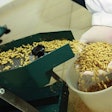The 2009 harvest, characterized as unusually late, wet and followed by a warmer-than-average winter, has raised grain quality concerns among grain handlers, processors and users across the country. Over the past decade, grain quality has been generally good and taken for granted, but faced with today’s grain condition challenges, grain elevator operations managers are looking for better ways to monitor their stored grain.
A joint research effort by Kansas State University and Purdue University, with the help of BinTech and The Andersons, Inc, has answered their call for help. They’ve developed a new method of measuring grain quality by using CO2 readings as an early indicator for problems such as spoilage, mycotoxins or insect infestation. High CO2 levels indicate a problem because as grain decays and breaks down, it gives off heightened levels of CO2. The higher the level, the more deterioration is likely.
The research project, now in its tenth year, has resulted in the first-ever continuous CO2 monitoring system, BinTechCO2, which will be commercially available in June this year. Using this system can aid in making educated business decisions, such as when to move, process or sell grain.
K-State/Purdue research project
Dr. Dirk E. Maier, Ph.D., P.E., professor and department head of grain science and industry at Kansas State University, initially began monitoring CO2 levels in 1998 on small 500-bushel-bins at Purdue University’s Post Harvest Research Center while serving as associate professor and extension agricultural engineer at Purdue. The first goal was to determine the smallest amount of CO2 activity that could reasonably be measured, and reveal what that activity represented in terms of grain spoilage in the structure.
“CO2 levels can be used as an early indicator of spoilage activity and we wanted to find out what the alert levels are — at what point should people take proactive grain quality management steps?” says Maier.
They found that cause for alarm occurs when the bin’s CO2 level reaches three to four times greater than the background CO2 level on a consistent basis. Generally, the background level for CO2 is around 400 parts per million (ppm). Readings around 1000 ppm indicate the bin should be watched; readings of 1200-1600 ppm means further investigation is required because there likely is a problem.
They also determined that a slow but growing background level can be indicative of an issue. For example, if the background level starts at 400 ppm and grows to 600 ppm and then 800 ppm over a span of weeks, it indicates there’s something at a low level going on in the bin, perhaps insects.
In 2000, Bob Marlow, operations manager of The Andersons Inc. Delphi, IN facility, located 20 miles outside of Purdue University, signed on to be a part of Maier’s study. The research team applied the same technology used on the smaller bins at Delphi’s 500,000-bushel-bins. Today, a total of 20 pilot facilities in Indiana and Kansas are participating in field work and producing data for the project every day.
Guy Fromme, founder and general partner of BinTech, Denver, CO, played an integral role in Maeir’s research from the beginning by providing custom-made, permanently mounted CO2 sensors. Over time, the project answered basic questions regarding sensor placement in the bin, number of sensors required in the bin and how to design a sensor that addressed the air-entrained grain dust while having the desirable characteristics of low maintenance and low cost.
The result is BinTechCO2, the grain industry’s first commercially available fixed CO2 monitoring device that will be available for purchase this summer.
A new tool in the box
The most accurate way to describe BinTech CO2 is as a grain management tool.
The system works with a small solar-charged control box that mounts on the bin roof. The control box collects and buffers in-bin data and sends that to BinTech’s secure central server once or twice per day.
The BinTechCO2 sensor is inserted through the bin roof and suspends down into the headspace. The sensor’s default setting will take automatic readings every hour, however, the interval can be changed to take readings more or less frequently if needed.
Installation and startup is simple and isn’t influenced whether the bin is empty or full. The installer simply cuts a small access hole in the roof for the sensor, feeds the sensor through, mounts the box, swivels the solar panel to face south and flips the “on” switch. Lastly, BinTech calls the customer to verify identifying information about the sensor and its location, such as bin number, serial number, etc. Registered users can then log into BinTech’s data viewing website, click on the bins they want to see, and view any bin’s CO2 trend data over the last few days, weeks or months.
The data is also closely monitored by BinTech’s staff. “A key convenience feature of BinTechCO2 is that we monitor here the CO2 levels in each bin and, using proprietary software, determine which bins have normal conditions, which should be watched more closely and which should have an alert sent to the customer to advise them about the concern,” says Fromme. “Customers have found this very useful and have confirmed the problem by inspecting the bin and used the knowledge to make real-time grain decisions.”
Once installed, the system is completely self-sufficient. The Andersons’ Marlow says the system is very user-friendly. “There’s absolutely no impact on our day-to-operations where we physically have to do something,” he says. “It’s not intrusive to our operation at all. It’s like a grain temperature monitoring system that sits in the background, continuously collecting data for you.”
Fromme says its retail price will be approximately half the price of a modern grain temperature cable system and includes the first year of monitoring. After the first year, a modest subscription is required to cover the cellular data access, database maintenance and customer alerting services.
But when it comes to predicting grain quality, the return on investment is more important than the investment itself.
Why monitor CO2?
So how can monitoring CO2 levels help increase your bottom line? It allows users to compare information from one bin to another to determine how best to use the grain in each bin.
“If something indicates there may be a problem in one bin, but no foreseeable problems in another bin, that can help me make some real decisions that will pay back immediately,” says Maier. “If you’re going to be selling, shipping or processing some grain, you can now have the knowledge to take it first out of the bin that has some quality concerns and hold on to the more stable quality grain for longer periods of time. That’s how companies will make money off of this system.”
Marlow recalls the benefits his facility reaped from the first time he used CO2 monitoring technology.
“We had built a corn pile in the fall during a period of heavy rain,” says Marlow. “The uncovered pile got about six to eight inches of rain on it while we were building it. We knew we had problems just from walking on the grain surface and within a week we started looking at CO2 levels with Purdue. The readings were in the 3000 ppm to 4000 ppm range and Dirk suggested we immediately do something about it, so we reclaimed the pile as quickly as we could. Had it not been for the CO2 monitoring, I can’t say how long we would’ve left it out, because without temperature cables we didn’t have any other indicators to go by, except for odor and visual cues.”
Fromme points out another major return on investment: a safer workforce. “Farm and elevator workers are killed or injured each year due to grain engulfment accidents. Most of these incidents stem from actions taken to either assess or mitigate severe spoilage inside storage bins. The BinTechCO2 holds the promise of earlier spoilage detection and a reduced need to enter the confined space of grain bins.”
Some of the benefits of CO2 monitoring can be achieved by using hand-held sensors instead of, or in addition to, permanently fixed sensors like BinTechCO2.
An alternative sensor
Two of The Andersons’ 500,000-bushel wheat tanks are equipped with the BinTechCO2 monitoring system. On the remainder of Delphi’s bins and grain piles, Marlow takes weekly CO2 readings using a Telaire 7001 model hand-held CO2 sensor.
With this method, the first step is to turn on the aeration fans for about 10 minutes before taking a reading because CO2 can accumulate in the ductwork, and taking a reading immediately after turning on the fan may produce an inaccurate reading.
Then an employee simply climbs the bin and holds the sensor in the stream of the fan’s exhaust to take a reading. It takes no more than one and a half hours for one employee to complete this task on all of the Delphi facility’s bins and piles.
Marlow enters the data, such as which bin and which fan the reading came from, the temperature, the background CO2 level and the CO2 level from the exhaust, into a spreadsheet and carefully analyzes it weekly. He keeps an eye out for any major inconsistencies between the background CO2 level and the exhaust fan CO2 level, and has been pleased with the results of using this method.
However, Tim O’Connor, co-general partner with BinTech, cautions that there are some drawbacks to using hand-held sensors.
“In order to get quality data out of a bin, you have to measure it at the same time every day you measure because the actual temperature of the headspace in the bin will vary by tens of degrees throughout a 24 hour period,” O’Connor says. “The temperature fluctuation influences the movement of air in the bin and CO2 in the air. The stationary sensor takes a reading every hour, knows the temperature pattern and accounts for it. If you’re taking hand-held readings every couple days, you don’t know what the cyclical pattern in that bin is, which can lead to errors in interpreting the data and overlooking a potential problem.”
Fromme says hand-held sensors may be better suited for monitoring temporary grain piles than BinTechCO2 because of how grain piles use a vacuum to pull air downward. The first version of BinTechCO2 is intended for mid-size permanent storage bins, but the company is working on a version of fixed CO2 sensors that will be effective on grain piles. In the meantime, Fromme believes the inexpensive — less than $500 per sensor — hand-held monitors can be substituted.
Continued research
The K-State/Purdue research project recently received a grant from the Kansas Corn Growers Association and will continue to look for better ways to interpret CO2 data.
“The project will continue, but our primary objective now is doing more intensive grain sampling and analyzing in our grain and feed microorganism and toxicology lab,” says Maier. “Currently, the relationship between CO2 levels in the bin and what is actually happening with the microorganisms to make the CO2 readings increase, has not been well-established. In our lab we can evaluate the mold, mycotoxins and any other microorganism present to try and relate that presence to the CO2 readings.”
Fromme and O’Connor are also dedicated to helping fund future post-harvest issues research at K-State by donating a portion of the proceeds from every BinTechCO2 to the university.
“The end-user, through purchase of this product, can help fund future research even into areas that don’t necessarily benefit BinTech,” says Fromme. “We’re doing this in response to an industry-wide concern about how to fund future research.”
After a difficult harvest year like 2009, elevator managers could use all the help they can get. Whether using hand-held sensors on temporary grain piles or BinTech’s permanently mounted sensors on a 500,000-bushel grain bin, research on CO2 monitoring has proven that the practice can effectively detect grain quality issues early on and can help elevator managers make smart business decisions.

















